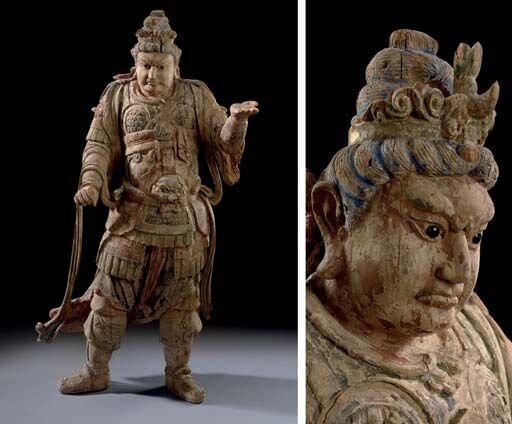A large painted wood figure of a Guardian King, Song-Yuan dynasty, 13th-14th century
Lot 227. A large painted wood figure of a Guardian King, Song-Yuan dynasty, 13th-14th century; 64 in. (162.5 cm.) high. Estimate USD 350,000 - USD 450,000. Price realised USD 384,000. © Christie's Images Ltd 2007.
The powerful figure shown standing with feet firmly braced slightly apart and with right hand positioned as if holding the hilt of a sword that would have rested in the palm of the raised left hand, wearing elaborate layered armor with a monster mask at the waist, and a long celestial scarf draped over the shoulders and looped over the arms, his face carved with fierce expression intensified by black glass pupils, the hair painted blue and drawn up behind a phoenix crown into a tall interwoven topknot, with extensive traces of red, green, black, blue and dark flesh-colored pigment and gilding.
Provenance: Private collection, Italy.
Private collection, France.
Note: This powerfully sculpted figure represents one of the four 'Celestial Kings of the Directions' (Tianwang), the guardians of the four quarters of the world. Although the attribute of the present figure is missing, the positioning of his right hand suggests he originally held a sword, the attribute of Virudhaka, the Guardian King of the South.
A comparable wood figure of a Guardian King dated to the Jin dynasty wearing very similar layered armor, but of smaller size (118 cm. high) and shown standing in a less dynamic pose, was included in the exhibition, The Art of Contemplation - Religious Sculptures from Private Collections, National Palace Museum, 1997, pp. 210-11, no. 94. The distinctive facial features and headdress of the present figure, as well as the broad, corpulent physique, are also comparable to those of a wood torso of a bodhisattva dated to the late Song dynasty and a wood figure of a standing Guanyin inscribed with a date corresponding to 1282, both of which are illustrated by A. Priest, Chinese Sculpture in the Metropolitan Museum of Art, New York, 1944, pl. CXV, cat. no. 68, and pl. CXVI, cat. no. 69. See, also, the four Guardian Kings wearing similar attire and standing in similar postures illustrated by M. Gridley, Chinese Buddhist Sculpture under the Liao, New Delhi, 1993, p. 83, nos. 122a and b.
Christie's. Fine Chinese Ceramics & Works of Art, New York, 22 March 2007

/https%3A%2F%2Fprofilepics.canalblog.com%2Fprofilepics%2F1%2F0%2F100183.jpg)
/https%3A%2F%2Fstorage.canalblog.com%2F03%2F02%2F119589%2F96711876_o.jpg)
/https%3A%2F%2Fstorage.canalblog.com%2F11%2F31%2F119589%2F94773502_o.jpg)
/https%3A%2F%2Fstorage.canalblog.com%2F20%2F83%2F119589%2F94772815_o.jpg)
/https%3A%2F%2Fstorage.canalblog.com%2F26%2F72%2F119589%2F75604929_o.jpg)
/https%3A%2F%2Fstorage.canalblog.com%2F59%2F60%2F119589%2F26458628_o.jpg)



/http%3A%2F%2Fstorage.canalblog.com%2F41%2F21%2F119589%2F127641215_o.jpg)
/http%3A%2F%2Fstorage.canalblog.com%2F91%2F30%2F119589%2F126160632_o.jpg)
/http%3A%2F%2Fstorage.canalblog.com%2F15%2F06%2F119589%2F126160241_o.jpg)
/http%3A%2F%2Fstorage.canalblog.com%2F01%2F87%2F119589%2F126159930_o.jpg)